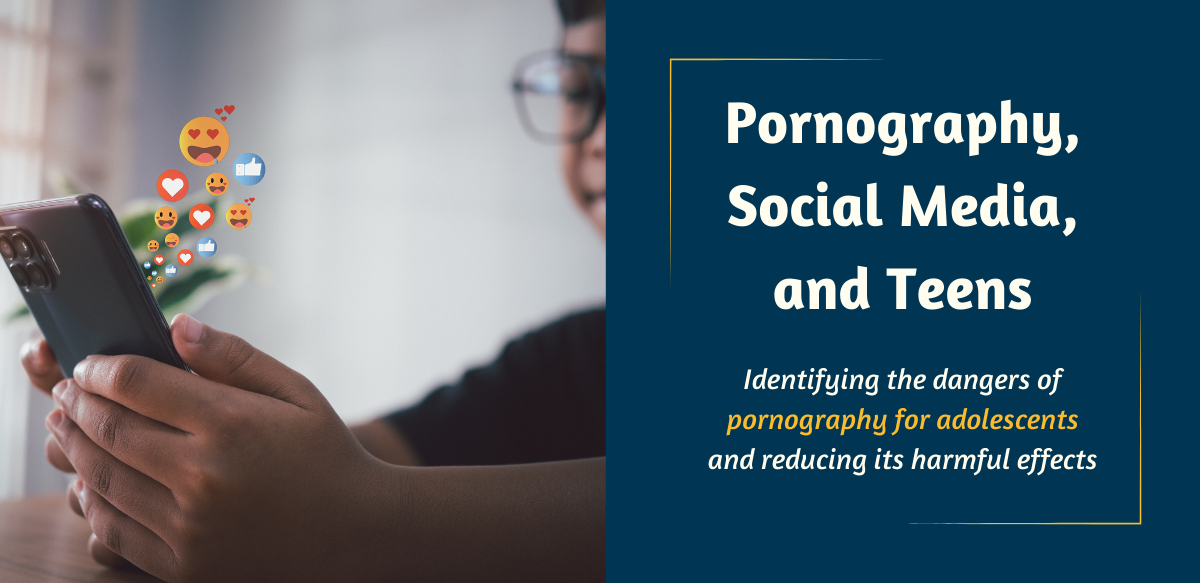
Adolescents have become increasingly exposed to pornography through social media, and with this comes potential dangers to their mental health. A recent Safer Society training titled “Pornography, Social Media, and Teens: What Could Go Wrong? And What Can Be Done to Make it Go Less Wrong?”—presented by Seth Wescott, LMLP and David Prescott LICSW, ATSA-F—focuses on the dangers of pornography for adolescents and how its harmful effects can be reduced.
Concerns Over Adolescent Exposure to Pornography
It may be difficult for researchers to determine precisely how adolescent exposure to sexually explicit material affects their developing attitudes and emotional health. Nonetheless, Wescott points out that while everyone wants to have happiness and pleasure in their lives, “No one is saying that porn is good for you.” In this training, the presenters discuss the connections researchers have made between pornography and adolescent development, including:
Desensitization Frequent exposure to exaggerated, bizarre, exploitative sexual behavior makes it difficult for anyone, but especially adolescents, to find sexual satisfaction in a healthy, mutually respectful sexual relationship.
“We don’t use the Fast and Furious movies to teach people how to drive. And learning about sex by watching porn is like learning to drive a car by watching NASCAR.”
– Attendee from the Pornography, Social Media, and Teens training.
Negative Self-Concept Adolescents who frequently view pornography may experience shame and guilt and have conflicts in their romantic relationships around sexuality. Sexting, for example, which has become part of everyday dating culture, can have negative consequences for adolescents, including social pressures to send sexually explicit material, fear of rejection, and bullying. Also, adolescents who consume pornography can experience a negative impact to their self-esteem due to the sharing of such images and the comparison of one’s body to the unrealistic and often manipulated images adolescents see on social media.
Misinformation The presenters discuss research findings from Emily F. Rothman (2021) in which a quarter of 18- to 24-year-olds indicated that pornography was their most helpful source of information about how to have sex. And it is well known that misinformation and conspiracy theories are rampant online. And yet, this is where many youths find incorrect information about such topics as menstruation, proper contraceptive use, and HPV vaccination. Social media is also not the place for adolescents to obtain accurate, unbiased information about issues such as gender identity, sexual orientation, and other LGBTQ+ issues.
Think You Know Where Adolescents Are Viewing Porn? Think Again.
One of the most surprising and enlightening segments of the training focuses on the many ways adolescents are accessing and sharing sexually explicit material. Many of us have heard of the popular site Pornhub, and we may be aware that young people view and share pornographic materials on apps such as Snapchat and TikTok, but if you think these are the only places young people are viewing and sharing porn, then you’ll find the hosts’ comparison of other lesser-known apps quite revealing. For example, have you heard of Yubo, Meet Me, and KIK? How about Snack, Feels, and Lolly (or “Lolita porn”)? Prescott and Wescott break down these apps so you can tell how they differ on these important and potentially dangerous capabilities of modern apps:
- Anonymity
- Location sharing
- Age verification
- Content Monitoring
- Stranger-based
“…if you can imagine being sexual with it (anything, anyone), pornography exists of it.”
How Mental Health Professionals Can Help
Our goal when dealing with adolescents cannot be to prevent their exposure to all pornography or all sexting—which has become a common component of modern dating—but rather to help them become aware of the dangers of sexting and to emphasize the importance of consent, choice, and boundaries (i.e., nonconsensual sharing). Discussions around consent are vital since today only 10 states mandate that if sex ed is taught, it must include information about consent.
Other resources shared during the training, such as It’s Time We Talked and What’s Ok?, are some of the most useful online resources for adolescents. In addition, the presenters discuss one framework, called the Savvy Consumer Model, which specifically deals with how adults can help adolescents navigate the confusing world of porn-related dilemmas they’re likely to face as they mature.
There is no way to prevent adolescents from being exposed to pornography these days, and new ways will undoubtedly keep popping up. If you are a mental health professional, school counselor, or other professional working with adolescents, then this workshop will provide you with vital resources to help you better develop treatment plans with clients and families on topics such as consent, pornography use, sexting, and healthy sexuality.
Additional Resources
- Sexual Behaviors in the Current Era: A Conversation with Debby Herbenick
- Teens and Pornography
- The disaster of misinformation: a review of research in social media
- What’s OK? A New Resource for Teens and Young Adults from Stop It Now!
- Teens Are Watching Pornography, and It’s Time to Talk About It
References
Rothman, E. F. (2021). Pornography and Public Health. Oxford University Press.



